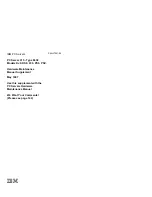
Device Server User Guide
64
correctly assigned.
•
If the IP address the device server is automatically assigned through a DHCP
server, the device server IP address may be changed. A fixed IP address is
assigned when the DHCP server assigns a permanent IP address to this device
server or the fixed IP address assignment is set in this device server.
•
A problem may occur from an incorrect or duplicate IP address. Check if the IP
address is assigned to the device server correctly and if the IP address is
assigned to another device on the network. In TCP/IP connection, IP address
confliction is the most frequent problem. If the IP address is incorrect, it may
be the problem of the device connection.
•
Check if the PC and the device server are using the same subnet mask. (For
example, if the device server uses the subnet mask of 255.255.255.0, the
computer should use the same subnet mask). In addition, check if the default
gateway is set correctly.
•
If an incorrect IP address is assigned, find the DHCP server and check if the
DHCP server assigned incorrect IP address to this device server.
Windows Problem
If connection to the device is not made properly in Windows, check the connection
status by PING x.x.x.x (x.x.x.x refers to this device server
’
s IP address)
command in command prompt. If Ping does not work proper, it can not connect to
serial device.
If a problem occurs when COM Port redirector is in use, check the right port is
being used when running application.
Firmware Update via FTP
This device server enables firmware upload via web and FTP. This chapter describes how
to update via FTP and Telnet. Update via web is explained in Ch. 5. Connect to this device
server through ftp program provided in Windows, and input username and password.
(Default “ devicemanager ” , “ 99999999 ” ) To check transmission mode and status,
enter bi and hash.
Send firmware to be upgraded to this device server by put command. If transmission is
complete, end ftp program by bye command.





































